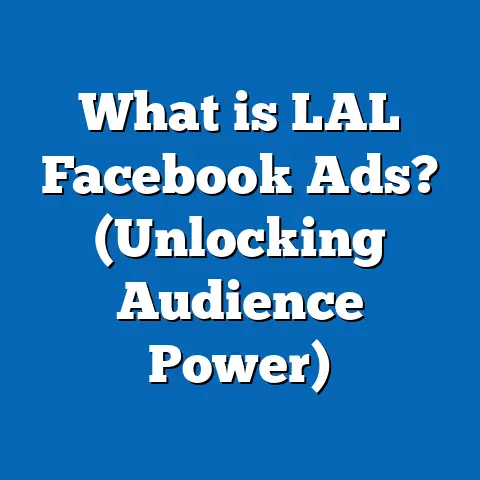What is the Facebook Ads Payment System? (Unlocking Revenue Streams)
What is the Facebook Ads Payment System? (Unlocking Revenue Streams)
Introduction: Busting the Myth About Facebook Ads Payments
Many marketers and business owners believe that Facebook Ads payment is just a simple transaction — pay to run ads, and watch your sales grow. However, this assumption overlooks the complexity and strategic potential embedded in Facebook’s payment system. Understanding how Facebook Ads payment works is crucial for unlocking new revenue streams and maximizing your advertising ROI.
Understanding the Facebook Ads Payment System
What is the Facebook Ads Payment System?
At its most basic level, the Facebook Ads payment system is the mechanism through which advertisers fund their campaigns on Facebook’s extensive advertising network. But it’s much more than a transactional gateway. It is an integrated financial management tool that connects your budget with your marketing strategy.
This system allows you to:
- Add and manage multiple payment methods
- Set billing thresholds and spending limits
- Monitor billing cycles and transaction histories
- Receive detailed invoices and payment receipts
Facebook’s payment system works seamlessly across all platforms within its ecosystem, which includes Facebook itself, Instagram, Messenger, and the Audience Network. This ensures advertisers can reach billions of users while maintaining strict control over their ad budgets.
The Importance of Understanding Payments in Facebook Advertising
Effective advertising is tightly linked to budget management. When you understand how payments work on Facebook Ads, you gain insights into how ad spend translates into results.
According to Meta’s (Facebook’s parent company) Q4 2023 report:
- Over 10 million active advertisers globally use Facebook Ads.
- The average cost per click (CPC) across industries ranges from $0.50 to $2.00.
- Small businesses that track ad spend closely report up to a 30% higher ROI.
These data points highlight how crucial managing payments and budgets is for campaign success. Ignorance or mismanagement can lead to overspending or wasted ad budgets.
Key Components of the Facebook Ads Payment System
1. Payment Methods
Facebook Ads supports a variety of payment options that cater to different business sizes and regional regulations:
- Credit/Debit Cards: Visa, MasterCard, American Express, Discover, Maestro. This is the most widely used method due to instant processing.
- PayPal: Offers secure and easy payments without sharing card details.
- Manual Payments: Advertisers prepay an amount into their account to be used for ads until depleted.
- Direct Debit & Bank Transfers: Available for larger advertisers or specific countries.
- Facebook Ad Coupons and Credits: Occasionally distributed as promotional incentives to new advertisers or during campaigns.
Each method has its pros and cons:
| Payment Method | Pros | Cons |
|---|---|---|
| Credit/Debit Cards | Instant, widely accepted | Risk of declined transactions |
| PayPal | Secure, easy to use | Not available in all countries |
| Manual Payments | Full spending control | Requires upfront funding |
| Bank Transfers | Suitable for large budgets | Longer processing times |
| Ad Coupons | Free ad credits | Limited availability |
2. Billing Thresholds
Billing thresholds are a unique feature within Facebook’s payment system designed to balance advertiser convenience with Facebook’s risk management.
- What are Billing Thresholds?
They are predetermined spending limits at which Facebook charges your payment method automatically. - How Billing Thresholds Work:
When you first start advertising, your threshold might be $25. Once you reach this spend, Facebook bills your card immediately. If payments go through successfully over time, this threshold can increase (e.g., $50, $250, up to $750 or higher). - Why it Matters:
This staged billing reduces risk for both advertisers and Facebook. Advertisers aren’t charged for large amounts upfront, while Facebook minimizes losses from failed payments.
3. Billing Cycle
The billing cycle refers to how frequently Facebook charges your account.
- You may be charged when you reach your billing threshold.
- Alternatively, if you don’t reach that threshold by the end of the month, you get billed for whatever you spent.
- For manual payments, you are billed upfront.
Understanding your billing cycle helps you forecast cash flow and avoid surprises on statements.
4. Spending Limits
Spending limits act as a hard stop on your total ad spend.
- These limits ensure you do not accidentally overspend beyond your set budget.
- You can set this limit in Ads Manager under Billing Settings.
- Once reached, all ads pause automatically until you increase or remove the limit.
This feature is especially useful for small businesses managing tight budgets or those running seasonal campaigns.
How Does Facebook Calculate Ad Costs?
The Auction-Based Pricing Model Explained
Facebook uses a real-time auction system to determine which ads get shown and at what cost. When advertisers submit bids for placements, an algorithm evaluates:
- The bid amount (how much you’re willing to pay)
- Estimated action rates (likelihood of user interaction)
- Ad quality and relevance scores (better ads cost less)
The auction selects winners based on total value rather than highest bid alone—this means a highly relevant ad with a lower bid can outperform a high bid with poor relevance.
Key Cost Metrics You Should Know
Understanding cost metrics helps you make informed decisions and optimize campaigns efficiently.
| Metric | Definition | Typical Range (USD) |
|---|---|---|
| CPC (Cost Per Click) | Cost when a user clicks on your ad | $0.50 – $2.00 |
| CPM (Cost Per Mille) | Cost per 1,000 ad impressions | $5 – $10 |
| CPA (Cost Per Action) | Cost when a user completes a desired action | $10 – $50+ depending on industry |
How Ad Quality Affects Cost
Facebook measures ad quality through user feedback, engagement rates, and click-through rates (CTR). A high-quality score reduces costs because Facebook favors ads users find relevant.
Case Study 1: E-commerce Business Optimizes Payment Settings to Boost ROI
Company: Trendy Apparel Co.
Challenge: The company was seeing rising ad costs with declining returns despite increasing budgets.
Solution Steps:
- Analyzed Billing Thresholds: They found frequent small payments fragmented their budget management.
- Switched to Manual Payments: This gave them upfront control over spend.
- Set Spending Limits: Prevented overspending during promotional campaigns.
- Monitored Billing History Weekly: Detected duplicate charges early.
- Improved Ad Quality: Reduced CPC by optimizing creative assets.
Results After 3 Months:
- 20% reduction in ad spend waste.
- 15% increase in conversion rates.
- Clearer cash flow management aligned with sales seasons.
Case Study 2: Small Business Uses Payment Insights to Scale Effectively
Company: Local Bakery Chain
Problem: Limited marketing budget with unpredictable cash flow made ad spending risky.
Actions Taken:
- Added PayPal as a backup payment method.
- Set low initial spending limits.
- Used detailed invoices for monthly accounting reconciliation.
- Leveraged billing alerts for spend tracking.
Outcome:
- Avoided missed payments during low cash flow months.
- Increased monthly ad budget by 50% without financial stress.
- Improved transparency for stakeholders via billing reports.
Deep Dive: How to Manage Your Facebook Ads Payments Like a Pro
Step 1: Adding and Managing Multiple Payment Methods
Adding multiple payment methods ensures uninterrupted campaigns even if one method fails.
- Go to Ads Manager → Billing → Payment Methods → Add Payment Method.
- Add credit card(s), PayPal or bank transfer options.
- Set a primary payment method and backup options.
Step 2: Setting Spending Limits Strategically
Spending limits protect you from unexpected overcharges.
- Determine monthly or campaign budget.
- Set limit slightly above expected spend for flexibility.
- Adjust limit after reviewing performance data every month.
Step 3: Monitoring Billing Thresholds Regularly
Know when you will be charged next:
- Check threshold status under Billing Summary.
- Understand that thresholds increase with consistent payments.
- Plan cash flow accordingly around billing events.
Step 4: Reviewing Billing History and Invoices
Accurate recordkeeping is essential:
- Access Billing → Transaction History.
- Download invoices for accounting purposes.
- Cross-check charges against campaign dates and spend reports.
Step 5: Handling Payment Failures Promptly
If a payment failure occurs:
- Update or add new payment methods immediately.
- Pause critical campaigns if funds are tight.
- Reach out to Facebook Support for disputed charges.
Comparing Facebook Ads Payment System with Other Leading Platforms
Google Ads vs Facebook Ads Payment Systems
| Feature | Facebook Ads | Google Ads |
|---|---|---|
| Payment Methods | Credit cards, PayPal, manual payments | Credit cards, bank transfers |
| Billing Thresholds | Yes; thresholds increase gradually | No; billed monthly or post-pay |
| Spending Limits | Yes | Yes |
| Currency Support | Supports over 160 currencies | Supports multiple currencies |
| Invoice Availability | Available for large advertisers | Available for all advertisers |
Google Ads lacks a billing threshold system but offers more immediate monthly post-pay billing cycles. Facebook’s tiered thresholds give advertisers more control early on.
Advanced Features and Trends in Facebook Ads Payment System (2024 Update)
Cryptocurrency Payments Piloted in Select Markets
Meta announced pilot programs allowing certain advertisers in regions like Canada and Europe to pay using cryptocurrencies such as Bitcoin and Ethereum. This could pave the way for faster international transactions without currency conversion fees.
Enhanced Billing Transparency Tools
A newly released dashboard gives advertisers detailed breakdowns per campaign, showing exactly where each dollar was spent across placements and devices in near real-time.
Integration with Accounting Software
Facebook has partnered with major accounting software providers like QuickBooks and Xero to allow automatic import of billing data for easier bookkeeping.
AI-powered Spend Forecasting
New AI tools predict future ad spend based on historical data combined with industry trends, helping businesses plan budgets more accurately across quarters.
Practical Applications: Mastering Payments to Unlock Revenue Streams
Understanding payment systems unlocks multiple revenue opportunities:
- Improved Budget Allocation: Knowing exact costs allows better focus on high-performing campaigns.
- Cash Flow Management: Businesses can align advertising spend with revenue cycles.
- Risk Reduction: Spending limits prevent budget overruns that could jeopardize operations.
- Scaling with Confidence: Larger budgets require confidence in billing processes; mastering payments enables scaling without fear of surprises.
- Fraud Detection: Regular review of transactions uncovers unauthorized activity quickly protecting assets.
Common Mistakes Businesses Make with Facebook Ads Payments
- Ignoring Spending Limits: Leads to unexpected charges and cash flow issues.
- Not Reviewing Billing History: Missing duplicate charges or errors that add up significantly.
- Single Payment Method Dependence: Campaigns pause if card declines or expires.
- Underestimating Billing Thresholds: Leads to confusion when charged unexpectedly mid-month.
- Failing to Reconcile Invoices: Causes accounting discrepancies affecting financial reports.
Avoid these pitfalls by setting clear processes around payments management.
Real-world Tips from Industry Experts
“The biggest mistake I see is not understanding billing thresholds — clients get surprised when they are charged multiple times a month.” — Sarah J., Digital Marketing Consultant
“Manual payments are a lifesaver for small businesses who want total control over their ad spend.” — David T., E-commerce Growth Strategist
“Always keep multiple payment options updated; downtime kills momentum.” — Lisa M., Social Media Manager
Frequently Asked Questions (FAQ)
Q1: Can I change my payment method after setting up ads?
Yes, you can add or remove payment methods anytime in your billing settings without interrupting active campaigns.
Q2: What happens if my payment method fails during an active campaign?
Facebook pauses your ads until a valid payment method is added or updated. You receive notifications via email and dashboard alerts.
Q3: Is there a minimum budget requirement?
No minimum budget exists; however, your billing threshold determines how often you get billed based on spend accumulation.
Q4: How can I get an invoice for my ad spend?
Invoices are downloadable from the Billing section inside Ads Manager under Transaction History.
Summary & Next Steps
Mastering the Facebook Ads payment system goes beyond simply adding a credit card. It involves understanding payment methods, billing thresholds, cost metrics, and spending controls to maximize your advertising investment.
Key Takeaways:
- Use flexible payment options suited to your business size.
- Monitor billing thresholds to avoid surprises.
- Set spending limits for risk management.
- Leverage detailed billing reports for data-driven decisions.
- Stay updated with new features like cryptocurrency payments.
Next Steps:
- Review your current payment setup in Facebook Ads Manager.
- Set appropriate spending limits aligned with your budget.
- Track billing history monthly to optimize cash flow.
- Experiment with manual payments if automatic billing feels risky.
- Explore integration options with your accounting tools.
With these insights, you can confidently manage your Facebook ad spending and unlock new revenue streams efficiently.






